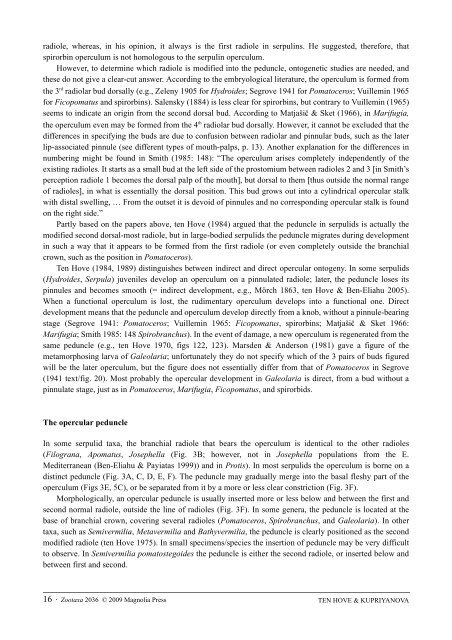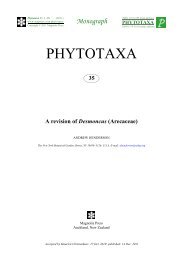Zootaxa, Taxonomy of Serpulidae (Annelida ... - Magnolia Press
Zootaxa, Taxonomy of Serpulidae (Annelida ... - Magnolia Press
Zootaxa, Taxonomy of Serpulidae (Annelida ... - Magnolia Press
Create successful ePaper yourself
Turn your PDF publications into a flip-book with our unique Google optimized e-Paper software.
adiole, whereas, in his opinion, it always is the first radiole in serpulins. He suggested, therefore, that<br />
spirorbin operculum is not homologous to the serpulin operculum.<br />
However, to determine which radiole is modified into the peduncle, ontogenetic studies are needed, and<br />
these do not give a clear-cut answer. According to the embryological literature, the operculum is formed from<br />
the 3 rd radiolar bud dorsally (e.g., Zeleny 1905 for Hydroides; Segrove 1941 for Pomatoceros; Vuillemin 1965<br />
for Ficopomatus and spirorbins). Salensky (1884) is less clear for spirorbins, but contrary to Vuillemin (1965)<br />
seems to indicate an origin from the second dorsal bud. According to Matjašič & Sket (1966), in Marifugia,<br />
the operculum even may be formed from the 4 th radiolar bud dorsally. However, it cannot be excluded that the<br />
differences in specifying the buds are due to confusion between radiolar and pinnular buds, such as the later<br />
lip-associated pinnule (see different types <strong>of</strong> mouth-palps, p. 13). Another explanation for the differences in<br />
numbering might be found in Smith (1985: 148): “The operculum arises completely independently <strong>of</strong> the<br />
existing radioles. It starts as a small bud at the left side <strong>of</strong> the prostomium between radioles 2 and 3 [in Smith’s<br />
perception radiole 1 becomes the dorsal palp <strong>of</strong> the mouth], but dorsal to them [thus outside the normal range<br />
<strong>of</strong> radioles], in what is essentially the dorsal position. This bud grows out into a cylindrical opercular stalk<br />
with distal swelling, … From the outset it is devoid <strong>of</strong> pinnules and no corresponding opercular stalk is found<br />
on the right side.”<br />
Partly based on the papers above, ten Hove (1984) argued that the peduncle in serpulids is actually the<br />
modified second dorsal-most radiole, but in large-bodied serpulids the peduncle migrates during development<br />
in such a way that it appears to be formed from the first radiole (or even completely outside the branchial<br />
crown, such as the position in Pomatoceros).<br />
Ten Hove (1984, 1989) distinguishes between indirect and direct opercular ontogeny. In some serpulids<br />
(Hydroides, Serpula) juveniles develop an operculum on a pinnulated radiole; later, the peduncle loses its<br />
pinnules and becomes smooth (= indirect development, e.g., Mörch 1863, ten Hove & Ben-Eliahu 2005).<br />
When a functional operculum is lost, the rudimentary operculum develops into a functional one. Direct<br />
development means that the peduncle and operculum develop directly from a knob, without a pinnule-bearing<br />
stage (Segrove 1941: Pomatoceros; Vuillemin 1965: Ficopomatus, spirorbins; Matjašič & Sket 1966:<br />
Marifugia; Smith 1985: 148 Spirobranchus). In the event <strong>of</strong> damage, a new operculum is regenerated from the<br />
same peduncle (e.g., ten Hove 1970, figs 122, 123). Marsden & Anderson (1981) gave a figure <strong>of</strong> the<br />
metamorphosing larva <strong>of</strong> Galeolaria; unfortunately they do not specify which <strong>of</strong> the 3 pairs <strong>of</strong> buds figured<br />
will be the later operculum, but the figure does not essentially differ from that <strong>of</strong> Pomatoceros in Segrove<br />
(1941 text/fig. 20). Most probably the opercular development in Galeolaria is direct, from a bud without a<br />
pinnulate stage, just as in Pomatoceros, Marifugia, Ficopomatus, and spirorbids.<br />
The opercular peduncle<br />
In some serpulid taxa, the branchial radiole that bears the operculum is identical to the other radioles<br />
(Filograna, Apomatus, Josephella (Fig. 3B; however, not in Josephella populations from the E.<br />
Mediterranean (Ben-Eliahu & Payiatas 1999)) and in Protis). In most serpulids the operculum is borne on a<br />
distinct peduncle (Fig. 3A, C, D, E, F). The peduncle may gradually merge into the basal fleshy part <strong>of</strong> the<br />
operculum (Figs 3E, 5C), or be separated from it by a more or less clear constriction (Fig. 3F).<br />
Morphologically, an opercular peduncle is usually inserted more or less below and between the first and<br />
second normal radiole, outside the line <strong>of</strong> radioles (Fig. 3F). In some genera, the peduncle is located at the<br />
base <strong>of</strong> branchial crown, covering several radioles (Pomatoceros, Spirobranchus, and Galeolaria). In other<br />
taxa, such as Semivermilia, Metavermilia and Bathyvermilia, the peduncle is clearly positioned as the second<br />
modified radiole (ten Hove 1975). In small specimens/species the insertion <strong>of</strong> peduncle may be very difficult<br />
to observe. In Semivermilia pomatostegoides the peduncle is either the second radiole, or inserted below and<br />
between first and second.<br />
16 · <strong>Zootaxa</strong> 2036 © 2009 <strong>Magnolia</strong> <strong>Press</strong><br />
TEN HOVE & KUPRIYANOVA
















